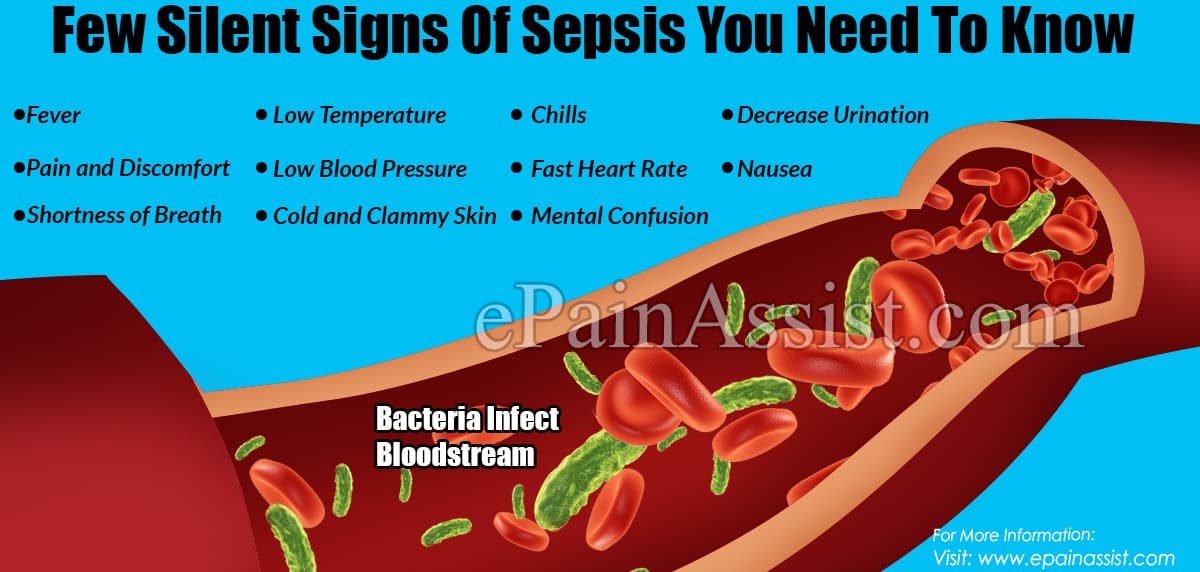Sepsis is a blood infection, difficult to diagnose and can cause death. It happens when a deadly infection from anywhere in the body enters the bloodstream. It is therefore important to know about the signs and symptoms to protect against this silent killer.
People with a weakened immune system are more vulnerable to it, but anyone can suffer from sepsis from an initial infection such as pneumonia, cut on arm or leg or urinary tract infection. Those suffering from diabetes, AIDS and kidney and liver disease are also at a greater risk.
If detected early, Sepsis can be easily treated with antibiotics but the symptoms can be confused with other condition which is why it often goes undiagnosed until late.

Few Silent Signs Of Sepsis You Need To Know
They are:
Fever
Fever is the first most important sign of sepsis. Sepsis occurs when the infecting organism enters the bloodstream and produce infection. Fever is an important sign of infection-induced systemic illness.
Low Temperature
Some toxins from sepsis can lead to an opposite effect and drop the body temperature leading to a low temperature.
Studies show that low temperature can be a sign of serious sepsis with a worse prognosis (1)
Though very rare but it is a matter of concern if the temperature drops too low.
Chills
Chills can accompany a fever and make sure you inform your doctor about it.
Chills are felt by the patient and cannot be observed by the doctor. Fever with chills is often mistaken for a viral infection.
Sepsis can be diagnosed when other symptoms are combined.
Pain and Discomfort
Pain and discomfort from a sepsis infection can be felt on a localized area or a specific spot.
Never ignore the discomfort in the area of injury as it can lead to a serious life-threatening condition.
Low Blood Pressure
Low blood pressure is a serious manifestation of infection. It might indicate a septic shock which is a more critical stage.
Low blood pressure happens as the blood vessels start losing fluid, relaxing the veins and the arteries, altering the way the blood moves through the body.
If the condition reaches a severe state, the low blood pressure does not respond to the fluid replacement and medicine need to be injected intravenously to raise the blood pressure.
Fast Heart Rate
When suffering from sepsis the heart tries to move blood more efficiently to fight illness. It is a common response of the body to any illness.
This leads to an increase in the heart rate as the heart pumps more strongly.
A heart rate of 90 beats per minute or greater can be a sign of sepsis.
Shortness of Breath
Another sign to identify sepsis is to watch out for the breathing rate. Sepsis can cause fast breathing as the infection in the lungs, cause decreased oxygen level. As the infection progresses the body needs for oxygen increase and its need to release carbon-dioxide increase. As the body responds to this the breathing rate increases and the patient feels short of breath.
Cold and Clammy Skin
During sepsis, the body diverts its energy and resources to the brain and heart and ignores the less critical organ, the skin.
This leads to an increase in the blood flow to the vital organs and reduces the flow to the skin, making it pale, cold, and clammy.
Mental Confusion
Just like any other illness, the body needs rest to fight off infection; similar is in the case of sepsis.
As the blood pressure falls, the blood flow to the brain is reduced which makes you feel sleepy and confused.
Decrease Urination
A decrease in urination is because of dehydration which can occur in the patients with sepsis.
This happens when while feeling sick you eat and drink less or you are throwing up or having diarrhea.
The urine in the case of sepsis is dark and smellier as the body tries to hold on as much fluid as possible. This also causes the kidneys to make less urine.
Nausea, Vomiting, And Diarrhea
A gut infection causing sepsis can lead to intestinal infections. There can be nausea, vomiting, and diarrhea, which can lead to excess loss of water giving rise to other sepsis symptoms.
Sepsis can be a life-threatening condition. It is therefore important to keep a track of the symptoms and keep the doctor informed about the same. In sepsis, every minute and hour counts especially when the infection is spreading fast.
